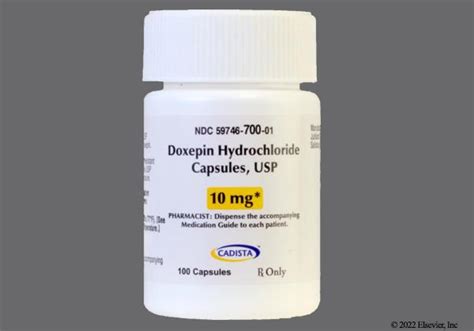Intro
Doxepin 10mg treats depression, anxiety, and sleep disorders, offering sedating effects and mood stabilization, with uses including insomnia and neuropathic pain management.
Doxepin is a medication that has been widely used for several decades, primarily for its antidepressant and anti-anxiety properties. However, its applications extend beyond these areas, making it a versatile drug in the field of psychiatry and neurology. One of the common dosages of doxepin is 10mg, which is often prescribed for various conditions due to its efficacy and relatively favorable side effect profile. Understanding the uses and effects of doxepin 10mg is crucial for both healthcare professionals and patients who are considering this medication as part of their treatment plan.
The importance of doxepin 10mg lies in its ability to address a range of psychological and neurological disorders. It belongs to a class of medications known as tricyclic antidepressants (TCAs), which work by altering the balance of certain natural chemicals (neurotransmitters) in the brain. By increasing the levels of serotonin and norepinephrine, doxepin helps to improve mood, reduce anxiety, and promote sleep. These effects are not only beneficial for individuals suffering from depression and anxiety disorders but also for those experiencing sleep disturbances.
Doxepin's mechanism of action and its effects on the brain and body make it a valuable treatment option for several conditions. Its ability to influence both serotonin and norepinephrine levels contributes to its therapeutic efficacy. Moreover, the 10mg dosage is often preferred for its balance between therapeutic benefits and potential side effects, making it a common starting point for many patients. As with any medication, it's essential to understand both the intended effects and the possible side effects of doxepin 10mg to ensure safe and effective treatment.
Introduction to Doxepin 10mg

How Doxepin 10mg Works
The therapeutic effects of doxepin 10mg are primarily attributed to its ability to increase the levels of certain neurotransmitters in the brain, such as serotonin and norepinephrine. These chemicals play a crucial role in mood regulation, sleep, and pain perception. By enhancing their availability, doxepin 10mg helps to alleviate symptoms of depression, anxiety, and insomnia. Its mechanism of action involves blocking the reuptake of serotonin and norepinephrine, thus prolonging their action in the synaptic cleft and enhancing their effects on the brain.Uses of Doxepin 10mg

Benefits of Doxepin 10mg
The benefits of doxepin 10mg include its efficacy in treating a range of psychological and neurological conditions, its relatively fast onset of action compared to some other antidepressants, and its availability in various formulations, which can enhance patient compliance. Additionally, doxepin 10mg is often considered for patients who have not responded adequately to other treatments, making it a valuable option in treatment-resistant cases.Side Effects of Doxepin 10mg

Serious side effects, although less common, can include increased risk of suicidal thoughts, especially in children and adolescents, cardiac arrhythmias, and seizures. It's crucial for patients to discuss any concerns or side effects with their healthcare provider to ensure safe and effective treatment.
Precautions and Interactions
When taking doxepin 10mg, it's essential to be aware of potential interactions with other medications and certain precautions. Doxepin can interact with a variety of drugs, including other antidepressants, antihistamines, and anti-anxiety medications, which may increase the risk of side effects. Additionally, doxepin 10mg should be used with caution in patients with certain medical conditions, such as glaucoma, urinary retention, and cardiovascular disease.Conclusion and Future Directions

Final Thoughts
For individuals considering doxepin 10mg as part of their treatment plan, it's essential to maintain open communication with their healthcare provider. Discussing expectations, concerns, and any side effects can help ensure that doxepin 10mg is used effectively and safely. As with any medication, patience and adherence to the prescribed regimen are crucial for achieving the best possible outcomes.What is doxepin 10mg used for?
+Doxepin 10mg is used for the treatment of depression, anxiety disorders, insomnia, and certain types of chronic pain.
How does doxepin 10mg work?
+Doxepin 10mg works by increasing the levels of certain neurotransmitters in the brain, such as serotonin and norepinephrine, which helps to improve mood, reduce anxiety, and promote sleep.
What are the common side effects of doxepin 10mg?
+Common side effects of doxepin 10mg include dry mouth, dizziness, drowsiness, constipation, blurred vision, and weight gain.
We invite you to share your thoughts and experiences with doxepin 10mg in the comments below. Your insights can help others better understand the uses and effects of this medication. If you found this article informative, please consider sharing it with others who might benefit from this information. Together, we can promote a better understanding of mental health treatments and support those seeking help.
